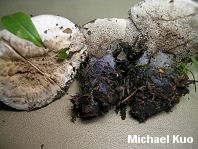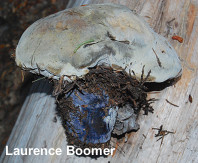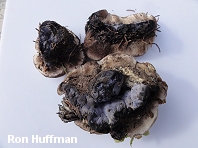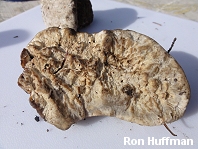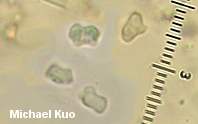| Major Groups > Toothed Mushrooms > Hydnellum > Hydnellum suaveolens |

|
Hydnellum suaveolens [ Basidiomycota > Thelephorales > Bankeraceae > Hydnellum ... ] by Michael Kuo Among the many species of Hydnellum that demonstrate blue shades, Hydnellum suaveolens is fairly easily separated with a combination of three features: a whitish cap, a purplish blue stem, and a strong fragrant odor. Yes, the cap can become dingy and brownish with age; yes, the stem is sometimes less blue than it "should" be; and yes, the odor can be weak or almost undetectable—but typical, fresh specimens generally tow the suaveolens line. Look for this gorgeous species under conifers—especially spruces—across North America. The West Coast's Hydnellum cyanopodium is similar, but its cap and flesh are more blue; additionally, its surfaces bleed red droplets when the mushrooms are fresh and young, and its spores are cruciate. It is associated with Sitka spruce. Thanks to Ron Huffman and Laurence Boomer for collecting, documenting, and preserving Hydnellum suaveolens for study; their collections are deposited in The Herbarium of Michael Kuo. Description: Ecology: Mycorrhizal with conifers (especially spruces); growing alone or gregariously; summer and fall; widely distributed in northern and montane North America, and on the West Coast from the San Francisco Bay Area northward. The illustrated and described collections are from Colorado and Oregon. Cap: Usually single but occasionally fused with other caps; 5–15 cm wide; convex, becoming flat; dry; velvety; becoming wrinkled, ridged, or pitted (sometimes cracking up into scales); white to whitish or very pale yellowish when fresh and young, becoming dingy grayish to brownish or olive over the center. Undersurface: Running down the stem; covered with crowded spines that are 3–7 mm long; whitish at first, becoming brownish to brown as the spores mature. Stem: 2–5 cm long; 1–3 cm thick at apex; more or less stubby and cylindric; purplish blue; bruising blackish blue where handled; dry; velvety. Flesh: Whitish to brownish, with zones of blue or brown (especially in the stem); tough but pliant. Odor and Taste: Odor strong and fragrant or minty, often developing slowly after the mushroom is picked; taste mild. Chemical Reactions: KOH on flesh bluish. Spore Print: Brown. Microscopic Features: Spores 4–6 x 2–4 µm; irregular; nodulose; hyaline to brownish in KOH. Clamp connections present. REFERENCES: (Scopoli, 1772) Karsten, 1879. (Fries, 1821; Saccardo, 1888; Coker & Beers, 1951; Hall & Stuntz, 1972; Smith, Smith & Weber, 1981; Baird, 1986; Phillips, 1991/2005; McNeil, 2006; Miller & Miller, 2006; Desjardin, Wood & Stevens, 2016; Siegel & Schwarz, 2016.) Herb. Kuo 09091101, 10151301. This website contains no information about the edibility or toxicity of mushrooms. |
© MushroomExpert.Com |
|
Cite this page as: Kuo, M. (2016, August). Hydnellum suaveolens. Retrieved from the MushroomExpert.Com Web site: http://www.mushroomexpert.com/hydnellum_suaveolens.html |
